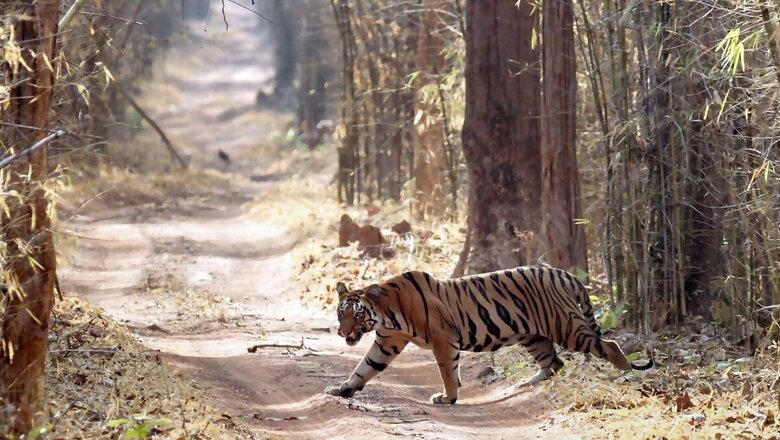
views
Commemorating the completion of the 50th anniversary of Project Tiger, Prime Minister Narendra Modi will release the latest tiger census data and release the government’s vision for tiger conservation during ‘Amrit Kaal’ at a mega event in Karnataka’s Mysuru on April 9.
A three-day event is slated to take place in Mysore from April 9, organized by the Central Government. The upcoming festivities will include the unveiling of the latest tiger census figures by Prime Minister Narendra Modi, as well as the release of a document evaluating the efficient management of tiger reserves and a vision statement outlining future efforts towards tiger conservation. Furthermore, the Prime Minister will also launch a commemorative Rs 50 coin in honor of the project.
What is Project Tiger?
India launched Project Tiger on April 1, 1973, to promote conservation and revive the dwindling tiger population. Initially, the project incorporated 9 tiger reserves spanning 18,278 sq km. Over the past 50 years, significant progress has been made towards this objective, and the number of tiger reserves has now increased to 53, encompassing an area of 75,500 sq km.
India has around 3,000 tigers, more than 70 per cent of the global wild tiger population, and the number is increasing at a rate of 6 per cent per year, according to latest official figures.
How are Tigers Counted?
According to the Wildlife Institute of India, the Capture-Mark-Recapture framework is a well-established method for estimating the abundance/density of elusive carnivores, such as tigers and leopards, through the use of camera trap surveys. The present technology is a huge improvement from the earlier method of studying tigers through tracing their unique and individual footprints or pugmarks on papers.
The camera trapping methodology involves taking photographs of individuals based on their distinctive pelage patterns, which can uniquely identify them. However, according to the experts, there is an increasing interest in broad-scale camera trap surveys for unmarked species as well. The development of Spatial Capture-Recapture (SCR) methods has improved density estimation by incorporating the spatial or “location” information of animal photo-captures and camera deployment. The data can also be analysed using conventional mark-recapture techniques, even outside a spatial framework, according to the official Phase III Camera Trapping Protocol manual.
According to an India Today report, for the tiger survey, India is divided into five zones, namely the Gangetic Plains, Central India and Eastern Ghats, Western Ghats, North Eastern Hills and Brahmaputra Flood Plains, and Sundarbans. In 2018, a comprehensive survey was conducted over an area of 381,400 square kilometers, covering 141 sites with a total of 26,838 camera trap locations.
According to wildlife conservationist Latika Nath, the reported numbers of tigers are likely an underestimate as camera traps are primarily placed in protected areas. As the population of tigers increases, they may venture beyond national park boundaries where camera traps are not present, she told the publication.
Azadi ka Amrit Mahotsav: Project Tiger
To commemorate the 75th anniversary of Indian independence on August 15, 2022, the Government planned to celebrate ‘Azadi Ka Amrit Mahotsav’ which included activities by The National Tiger Conservation Authority (NTCA) and Ministry of Environment Forest and Climate Change (MoEFCC), according to the 2021-22 annual report by the National Tiger Conservation Authority.
India for Tigers, a Rally on Wheels, had a significant impact as it traveled through 51 tiger reserves and 18 tiger range states, covering a distance of over 7500 km in just 7 days. It mobilized over 75,000 people across various tiger landscapes in India. The rally culminated in mega events held at Palamau, Sundarban, Similipal, Corbett, Manas, Bandipur, Melghat, Kanha, and Ranthambore, representing the country’s initial nine Tiger Reserves designated during the inception of The Project Tiger in 1973. These nine tiger reserves were the focal points of the grand celebration, according to the official report.
Synchronized Pan India Protection Patrol in Tiger Reserves was a nationwide synchronized protection patrol drive covering 75,000 km across 51 tiger reserves was planned to unite field formations and achieve the goal of wildlife conservation. Foot patrolling in 18 tiger range states throughout the country, with a total distance of approximately 218,123 km covered to date and the participation of 34,551 forest frontline forces was conducted.
NTCA initiated a program to promote tiger conservation by linking 750 schools, colleges, and universities with tiger reserves, encouraging them to participate in awareness and outreach activities over a 75-week period. Across 51 tiger reserves, various activities such as street plays, debates, painting/drawing competitions, quizzes, documentary/film shows, plantation drives, and webinars have been organized for school and college students. Additionally, rallies and visits to tiger reserves have been conducted to sensitize young generations about environmental issues, forests, and climate change, as well as the importance of tiger conservation. So far, 9,895 students have been sensitized across 18 tiger range states.
Progress
Additional Director General of Forests S P Yadav and the head of Project Tiger said there has been significant progress in the conservation of tigers in the country.
“There has been very significant progress… There is hardly any parallel in the world of a scheme of this scale and magnitude that has been so successful,” Yadav told PTI.
When asked about Project Tiger’s objective for the next 50 years, the official stated that the goal would be to establish a viable and sustainable tiger population in tiger habitats based on scientifically calculated carrying capacity. However, he did not specify a numerical target, stating that increasing the tiger population too quickly could result in conflicts with human beings.
According to Yadav, the government is committed to bringing potential tiger habitats under its conservation program and managing tiger reserves based on their carrying capacity.
Areas of Concern
The Project Tiger head pointed out that the tiger populations in some reserves, such as Buxa Tiger Reserve in West Bengal, Satkosia and Similipal in Odisha, and Satpura in Madhya Pradesh, are very low. “We need active management where tiger numbers are below or above the carrying capacity,”
Speaking about the future strategy for tiger conservation in the country he said, “We need to translocate these tigers to areas that have a good prey base and better chances of survival.”
Addressing issues regarding man-animal conflict, he said the government, with the help of the Wildlife Institute of India, has come up with guidelines for linear infrastructure and mitigation measures. “So, all proposals of projects in tiger corridors or tiger habitats, or buffer areas are put up before the standing committee of the NBWL (National Board for Wildlife) and implemented only after the recommendation of the panel which looks into all factors, including appropriate mitigation measures,” he said.
NTCA data shows that India lost 857 tigers between 2012 and 2020, while 193 of them died due to poaching. Such incidents came down substantially from 34 in 2018 to just seven in 2020. Calling poaching the number one treat to the tiget population in India, Yadav said, “poaching takes place in India not because there is a demand in our country, it is driven by the demand in consumer countries. Thanks to technology, better surveillance, patrolling and protection mechanisms, poaching has substantially reduced in India. But it still is the number one threat.”
Improved monitoring and early warning systems are crucial to reduce tiger-human conflicts, according to the official. Tigers need to establish their own territory after reaching maturity, which can lead to fights with existing tigers. If they lose, they move out in search of new territory, which is known as dispersal.
During dispersal, they may pass through tiger corridors that can be disturbed or diverted by roads, canals or other linear infrastructure, causing them to move into human habitats. However, it is not their natural behavior to identify humans as prey, Yadav said.
Read all the Latest India News here




















Comments
0 comment